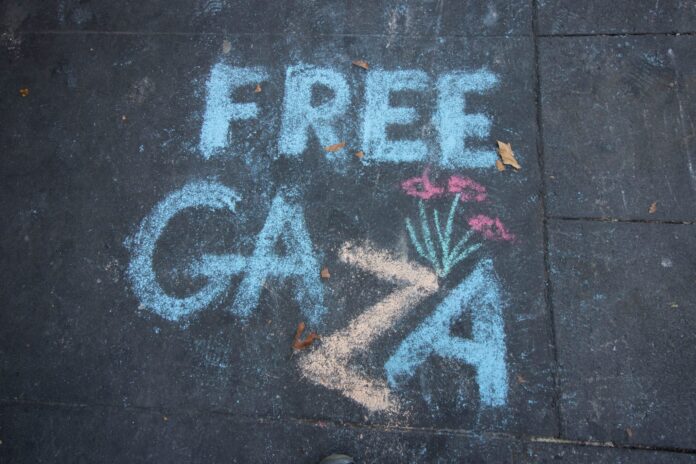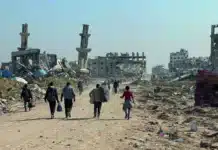While ISA welcomes the pause in the slaughter, we do not support the ceasefire “deal itself” in any way
Claire Laker-Mansfield, ISA International Political Committee
(This article was first published on 12 October 2025)
After two years of genocidal slaughter in Gaza, the first pause in the fighting for more than six months has come into effect on 10 October. As the agreed start time for the ceasefire approached, the IDF massively stepped up its bombardment of the strip – testament to the malicious cruelty with which the Israeli regime has conducted its war on the Palestinian people.
Any pause in the slaughter is of course desperately needed. ISA, along with millions of working-class people around the world, have been campaigning to end the bloodshed ever since it began. Assuming it holds for a period, the ceasefire should lead to a certain easing of the humanitarian crisis, though this will still be partial and inadequate. The Israeli regime has committed to allowing 600 aid trucks to enter the strip daily, which is roughly equivalent to pre-war levels. Given that this is a population which has been systematically bombarded, murdered, starved and denied life’s most basic necessities for months on end, even if this is delivered, it will still be far below the level of aid needed to begin to make life liveable again amid the devastation.
Yet as testament to the enormous strength of Palestinian resilience and hope, already, tens of thousands are starting the long march to return to their destroyed homes and neighbourhoods. They do so despite continuing to be threatened with deadly violence if they deviate from the Israeli military’s designated routes. A ceasefire can allow Palestinians the chance to come back together, to regroup and to redevelop collective organising and resistance. It can also give the workers’ and solidarity movement internationally time to absorb the lessons of the last months. While ISA welcomes the pause in the slaughter, we do not support the ceasefire “deal itself” in any way. It essentially dictates the surrender of the Palestinians to Israeli capitalism and US imperialism. The Israeli army will control at minimum 50% of Gaza for a long time. This comes with the added insult of war criminal Tony Blair being installed as a quasi dictator – heading up a so-called ‘Board of Peace’ to oversee the governance of the strip. No doubt he will also seek to personally ensure Trump’s real estate ambitions can be realised.
Why now?
Trump himself has driven the deal for two main reasons. One is his fear of the consequences of the Israeli state having gone so far that all regimes seen as complicit in the genocide – especially in the Arab world – would be vulnerable to an overwhelming backlash, potentially with revolutionary characteristics. The developing workers’ general strike movement in Europe, which reached a high-point in the movement in solidarity with the Sumud Flotilla, has created unprecedented pressure on governments in Italy and Spain in particular. The fear that the strike movements might grow and spread will have been another consideration.
It’s no accident that an idea similar to the deal was first floated earlier in the summer after an initial few strikes, but is being imposed now. Despite the lack of leadership offered by the bureaucratic heads of much of the trade union movement internationally, imperialism still fears the beginnings of a substantial mass working class resistance movement developing and deploying its most powerful weapon: strike action.
The other main reason Trump has pressed hard for a deal relates to the degree to which Netanyahu’s regime is seen by US imperialism as increasingly rogue and out of control. The botched attempt to assassinate Hamas’s top leaders while they were engaged in peace talks in Doha – on the soil of a key US ally – was important here. If such actions were to be repeated by the Israeli regime, it would threaten to destroy any hope of achieving what was on the cards before the 7 October Hamas attack: a ‘normalisation’ agreement in the region.
The deal also represents many of the surrounding Arab dictatorships essentially surrendering on behalf of the Palestinians. These treacherous regimes need and deserve to be overthrown on the basis of a mass revolutionary movement of the working class. Any ‘normalisation’ will now take place with Israel in an absolutely predominant position within the region. It has already altered the balance of forces within the Middle East in its favour through the last two years of war, not only on Gaza, but on Lebanon, on Iran, in Syria and against the Houthis. The almost daily bomb attacks on Lebanon shows how little a ceasefire deal is worth. The Israeli regime enjoys a seemingly bottomless commitment from western imperialism no matter what it does, continuing to be supplied with latest in weaponry, even by governments who have rhetorically condemned aspects of the genocide in response to public pressure.
But is the deal even a deal?
Trump clearly intends that this deal will end the most intense phase of genocidal slaughter. But he has no intention of providing the Palestinians with any real guarantees for their future safety. Meanwhile Netanyahu’s political career, which was on the ropes in the run up to 7 October 2023, is doomed whenever this war ends. The Israeli far right has been pushing for Israel to take direct control over Gaza, to exterminate and expel the Palestinian population, and to rebuild the strip with Jewish settlements. They now openly advocate for a resumption of the slaughter once the hostages have been returned. Meanwhile the Israeli working class has recently moved into struggle against the war (primarily on the basis of a desire to see the hostages returned). Between these two pressures, along with that of the White House, Netanyahu’s room for manoeuvre is increasingly restricted.
Any serious attempt to build a lasting peace in the region would see butchers like Netanyahu brought to justice for their crimes against humanity. Netanyahu has frequently used war on Palestinians as a means of bolstering his domestic support. He, and Trump, have also repeatedly responded to pressure from the Israeli far right, whose support Netanyahu requires in government, by ratcheting up the slaughter. All this means it is far from guaranteed that he will want to see this deal through to the end. Indeed, it is inevitable that attacks on Palestinians will continue in Gaza, even if they may be significantly less intense for a time. The ongoing violence and ethnic cleansing will continue in the West Bank too.
All this emphasises that we must continue to build and expand the mass movement in solidarity with the Palestinians all around the world. The campaign to break the siege should continue, to ensure Gazans have access to the levels of aid they really require – not the meagre rations Israel plans to allow a starved and devastated people. We call for a new and bigger flotilla – this time backed up by a general strike across Europe and the Middle East, as an important next step.
We say:
- Stop the genocide. For a permanent ceasefire, an end to the occupation and the blockade. Dismantle all Israeli settlements in the West Bank. For an urgent and massive humanitarian response to end the crisis in Gaza.
- Organize the mass opposition to the war across the Middle East into a huge, working-class-led movement to break the siege, end surrounding Arab governments’ complicity with genocide and occupation, and overthrow dictatorial regimes that exploit and oppress their own populations.
- No more arms for Israeli state terror – Genoa dockworkers show the way. The workers’ movement around the world should use its strength and power to help block the ongoing supply of weaponry and arms components to Israel.
- For a new aid flotilla – this time backed up by a general strike across Europe and the Middle East – to break the siege and get Gazans the aid they need.
- Reclaim the best traditions of the First Intifada. For mass Palestinian resistance across both the occupied territories and inside the Green Line. Build democratic, working-class organizations to escalate struggle via mass demonstrations, general strikes, and, where necessary, armed self-defence.
- Step up the anti-war movement within Israel and fight within it for a clear and comprehensive opposition to genocide, war, and occupation. Build links and solidarity between Israeli workers fighting back and Palestinian workers.
- For revolutionary change throughout the Middle East to end Palestinian national oppression. No to Tony Blair’s ‘Board of Peace.’ Build the struggle for socialist change to provide peace, democracy, and national rights to self-determination for all the peoples of the region, including a free, socialist Palestine.




